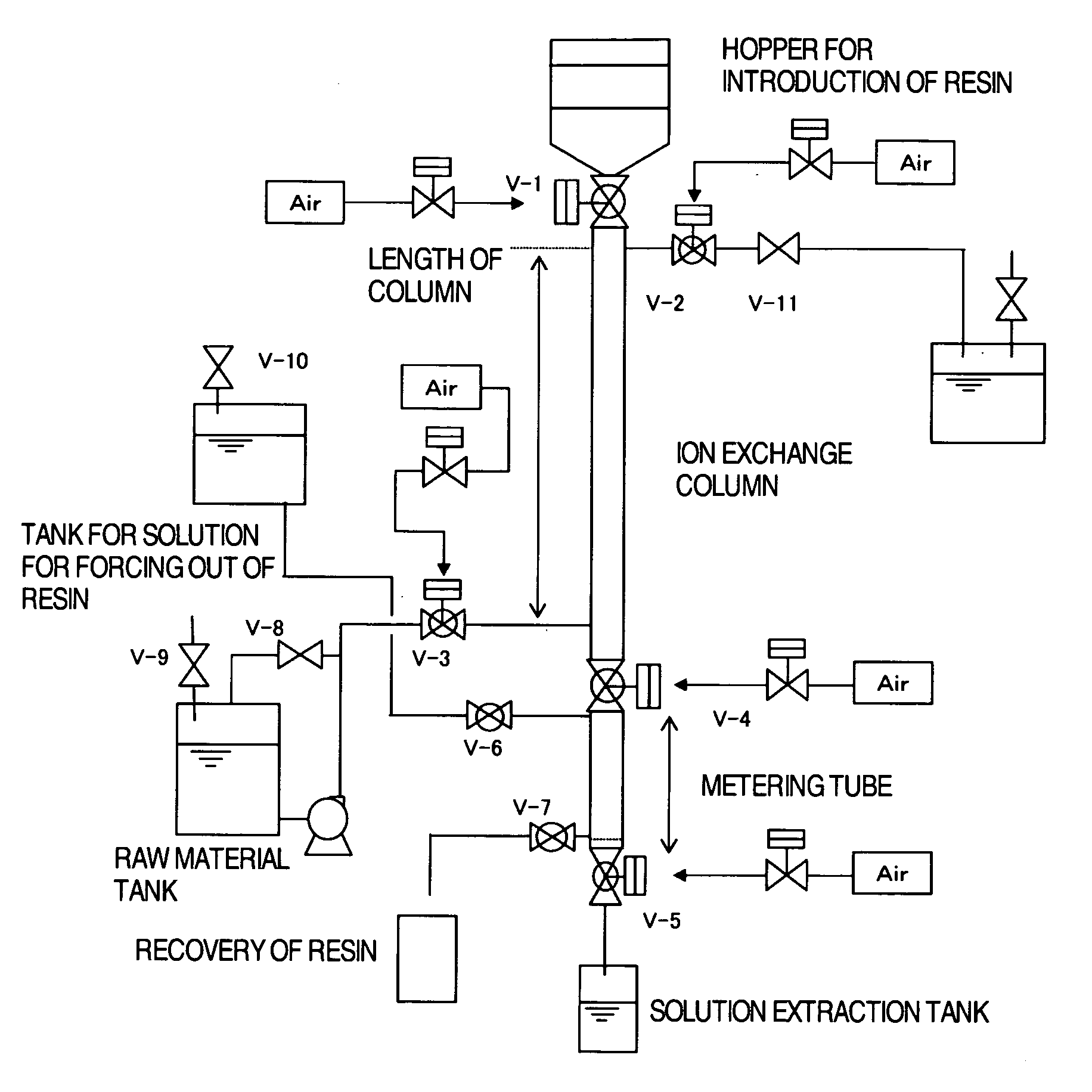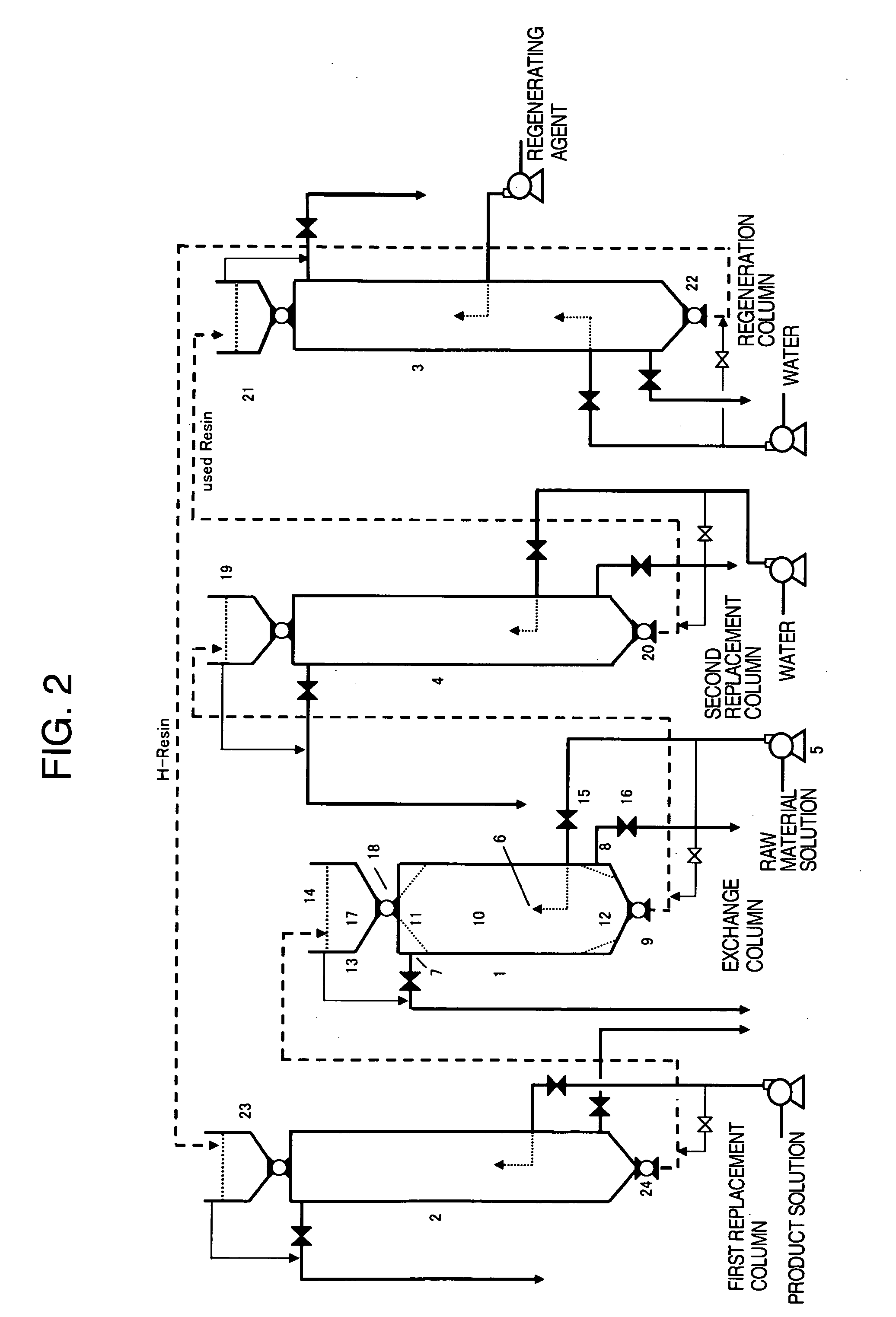Method for Purification of Amino Acid
- Summary
- Abstract
- Description
- Claims
- Application Information
AI Technical Summary
Benefits of technology
Problems solved by technology
Method used
Image
Examples
example 1
[0117] Experiment Simulating the Exchange Column
[0118] An ion exchange experiment (including simulating the exchange column) was carried out using an acrylic resin column of 26 mm in inner diameter which simulated a moving bed type continuous ion exchange apparatus. FIG. 3 shows the experimental apparatus used. Valves, V1-5 are air-actuation type ball valves made of a resin and can be opened and closed by a timer cycle control. Filters (folding-woven wire meshes made of stainless steel) were installed to the portions provided with V-2, 3, 5 so as to pass only liquid. The height of the exchange column (height from liquid feeding port to liquid recovering port) was 2 m, and the height of the metering tube (corresponding to the transfer length of resin per 1 cycle) was 34 cm. An H-form weakly acidic cation exchange resin (REBATID CNP-80WS manufactured by Bayer AG; total exchange capacity =4.30 eq / L-Resin (catalog value)) previously immersed in a glycine solution was charged in a hoppe...
example 2
[0123] Experiment Simulating the Second Replacement Column
[0124] A replacement experiment (including simulating the second replacement column) was carried out using the experimental apparatus (acrylic resin column) used in Example 1 including simulating the moving bed type continuous ion exchange apparatus. The height of the replacement column (height from solution feeding port to solution recovering port) was 3 m, and the height of the metering tube (corresponding to the transfer length of resin per 1 cycle) was 40 cm. An Na-form weakly acidic cation exchange resin (REBATID CNP-80WS manufactured by Bayer AG) used in Example 1 and previously immersed in a solution of sodium salt of glycine, was charged in the hopper for introduction of resin. Thereafter, V-1, 4 were opened to pack the ion exchange resin in the column and the metering tube. Ion-exchanged water was charged in a raw material tank and a tank for a solution used for forcing out of the resin. The replacing experimental o...
example 3
[0151] Passing of Solution by Batch Type Process
[0152] Simulating the aqueous solution of crude amino acid which is obtained in step (1) of the present invention, a simulated solution containing iminodiacetic acid, glycolic acid, and formic acid as by-products was prepared from reagents. Glycine concentration was 11.1% by weight, concentrations of the by-products, namely, concentration of iminodiacetic acid, was 1.26% by weight, that of glycolic acid was 658 wtppm and that of formic acid was 321 wtppm, and amount of sodium ion was 21 wt ppm. 730 g of the resulting aqueous solution of crude glycine (pH =3.6) was passed, in the manner of down flow, through a resin column packed with 100 ml of a weakly basic anion exchange resin AMBERLITE IRA-96SB (trademark) of OH-form manufactured by Organo Co., Ltd. to obtain an aqueous glycine solution. The operation temperature was 40° C., and the liquid hourly space velocity of solution passing was 4.6 (L / L / Hr). The state of ion exchanging of im...
PUM
| Property | Measurement | Unit |
|---|---|---|
| Molar density | aaaaa | aaaaa |
| Molar density | aaaaa | aaaaa |
| Molar density | aaaaa | aaaaa |
Abstract
Description
Claims
Application Information
 Login to View More
Login to View More - R&D
- Intellectual Property
- Life Sciences
- Materials
- Tech Scout
- Unparalleled Data Quality
- Higher Quality Content
- 60% Fewer Hallucinations
Browse by: Latest US Patents, China's latest patents, Technical Efficacy Thesaurus, Application Domain, Technology Topic, Popular Technical Reports.
© 2025 PatSnap. All rights reserved.Legal|Privacy policy|Modern Slavery Act Transparency Statement|Sitemap|About US| Contact US: help@patsnap.com



